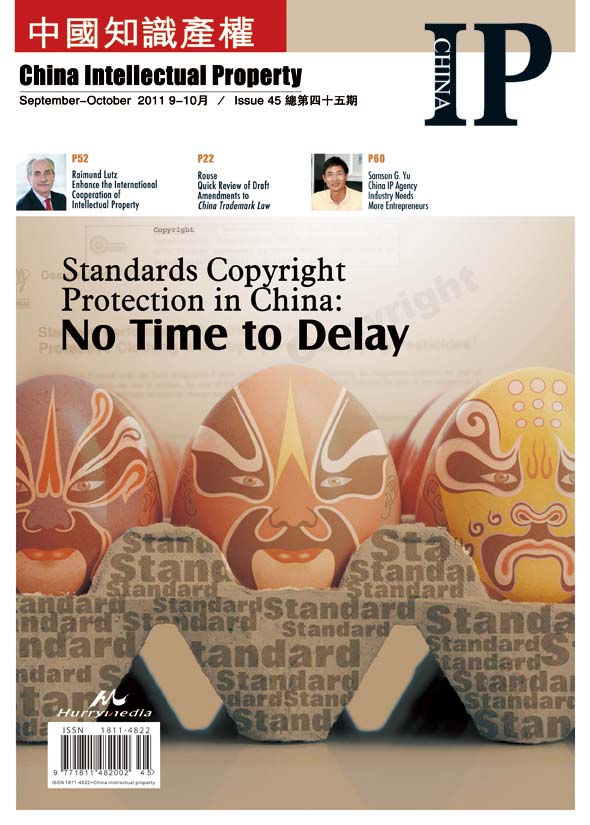The State Council’s Legislative Affairs Office recently released a further draft of the proposed amendments to the PRC Trademark Law (the “draft”). A deadline of 8 October 2011 has been set for the public to comment on the draft.
China’s Trademark Law, enacted in 1982, has already been revised several times: first in 1993, and again in 2001 when China joined the WTO. The latest amendments aim to further strengthen the trade mark system. A number of draft revisions have been issued over the past few years. This article highlights some of the most significant changes in the latest draft.
Scope of Protection
The scope of trademark protection has been extended to include single colour marks and sounds.
Registration Procedure
Multiple class applications are to be made available. The draft gives the State Council the power to formulate rules relating to multiple class applications at a later stage.
It will also be possible to file applications online.
During the application process, the China Trademark Office (“CTMO”) is granted the discretion to issue an examination opinion if it requires the content to be explained or amended. The failure to respond does not affect the determination of the CTMO.
Oppositions
The draft provides that only prior rights owners or interested parties are allowed to file oppositions.
One of the most significant procedural changes is the removal of an opponent’s right to appeal a decision of the CTMO in opposition proceedings. If the CTMO rules in favour of the applicant, the application will proceed to registration. The opponent’s only recourse will be to apply to the Trademark Review and Adjudication Board (TRAB) for cancellation of the registration. The applicant, however, will retain the right to appeal to the TRAB or the courts.
Well-Known Trademarks
Owners of registered or unregistered well-known trademarks will continue to have difficulty stopping bad faith applications as the existing law is maintained. An infringing mark must be a “copy, imitation or translation” of the well-known mark in question. This is a higher test than “identical or similar” in the 2010 draft. In the case of dissimilar goods, the suggestion from the 2010 draft that an infringing mark is one that “unfairly exploits or damages the obviousness or fame of the well-known mark” is rejected in favour of the original test of “misleads the public.” Ideally, we would like the law to prohibit marks which are “identical, similar or a translation” of an earlier well-known mark and provide for the concept of dilution.
Bad Faith Applications
The draft shies away from introducing a general “principle of good faith” in the application and use of a trademark, as had been proposed in the 2010 draft. Instead, the draft offers two alternatives: the first maintains the current language of the law; the second sets out what acts and scenarios constitute damage to other prior existing rights. The lack of a specific provision prohibiting bad faith filings remains a lacuna in the law. The first alternative is unacceptable given the limitations of the current law. The scenarios set out in the second alternative appear to be unacceptably narrow and rights owners will still struggle to prohibit many bad faith filings under the draft.
Enforcement
The draft does not assist in clarifying what constitutes “use” of a trademark. Language defining “use” similar to that existing in the Trademark Implementing Regulations has been imported into the draft, but it lacks sufficient clarity. Considering that in recent months, there have been a number of conflicting trademark infringement decisions relating to OEM use of a mark, it is disappointing that the new law does not provide clearer guidance.
The draft introduces heavier penalties for repeat infringers and an increase in statutory damages for trademark infringement from 500,000 RMB to 1,000,000 RMB. It is however unclear what is meant by a “repeat infringer.”
In order to make a claim for compensation for infringement of a registered mark, the draft includes a new requirement that the mark owner provide evidence of use of the mark in the previous three years. Apparently intended to prevent abusive enforcement of bad faith registrations, this provision instead places onerous and unnecessary burdens on legitimate rights owners. Compensation should be available as a matter of right, not conditional upon use.
The draft codifies the power of local administrative enforcement authorities to mediate questions of compensation incidental to their handling of administrative complaints.
Enforcement against the use of others’ mark in registered company names remains notoriously difficult, as relief is only available under the draft to an owner of a well-known mark.
Comment
Although a step in the right direction, we believe the draft does not go far enough to address the concerns of legitimate rights holders. Rouse is currently working with Chambers of Commerce and industry bodies to provide a coordinated response.




